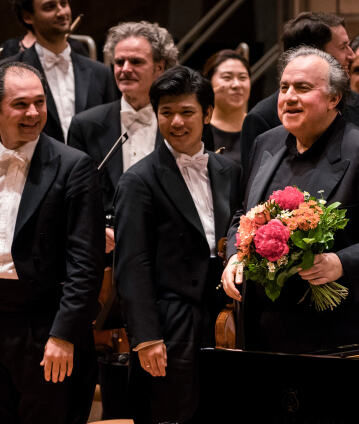Tugan Sokhiev and Yefim Bronfman perform Beethoven

Tugan Sokhiev, chief conductor of the Bolshoi Theatre, conducts two of the most popular works of the Russian repertoire at this concert, which opens with Prokofiev’s ardent Symphony No. 1, inspired by the First Viennese School. In contrast, Mussorgsky’s Pictures at an Exhibition depicts Russian scenes and legends with incomparable atmospheric and musical intensity. The soloist in Beethoven’s Piano Concerto No. 3 is Yefim Bronfman.
There can hardly be a better word to describe Yefim Bronfman’s piano playing than ʻsublimeʼ. When the American piano virtuoso with Russian-Jewish roots takes to his instrument, he sits there, still as a statue: Bronfman celebrates his art with stoic calm, and yet sets off a veritable storm of feeling with great emotional intensity. With regard to his controlled body language, the master pianist fondly remembers his colleague Arturo Benedetti Michelangeli: “He did not move one muscle too many. But if he once raised his eyebrows, that meant a lot. The music must show emotions, not me. I get paid to be a pianist, not a dancer or an actor.”
For his guest appearance in the Philharmonie, the pianist, together with the Berliner Philharmoniker and under the baton of Tugan Sokhiev, turns his customary imposing technique to Beethoven’s Third Piano Concerto in C minor, a key of particular significance to the composer. “This present concerto,” as the Allgemeine musikalische Zeitung wrote on 10 April 1805, “is one of the most important works by this genial master that have been published in recent years, and, in certain aspects, might even excel above all others. [...] with respect to its effect on the mind and with respect to its impact, this concerto is one of the most excellent among all that have ever been written [...].” A year earlier, in the edition of 15 August 1804, the same publication wrote: “This concerto incontestably belongs among Beethoven’s most beautiful compositions.”
After the interval, Tugan Sokhiev, music director of the Bolshoi Theatre and the Orchestre National du Capitole de Toulouse, has programmed Mussorgsky’s Pictures at an Exhibition. The piano cycle, written in memory of the painter Viktor Hartmann, takes the listener on a musical tour through an imaginary gallery, with the selected Hartmann exhibits portrayed with tone-painting effects and outward, immediately illuminating analogies between the artwork and the musical realisation. The most famous orchestral version of the cycle was written in 1922 at the suggestion of the conductor Sergei Koussevitzky and comes from none other than Maurice Ravel: as illuminated in the original black and white drawings of the piano and, as it were, coloured with the pallet of Impressionist sound refinements, it remains one of the most brilliant achievements of instrumentation history.
© 2018 Berlin Phil Media GmbH
Related interviews
Artists
Our recommendations
- Kurt Sanderling conducts Tchaikovsky and Saint-Saëns
- Simon Rattle and Yefim Bronfman
- Yannick Nézet-Séguin makes his debut with Berlioz and Prokofiev
- Simon Rattle conducts “Russian rhythms” at the Waldbühne
- Season opening 2012: Simon Rattle and Yefim Bronfman
- Daniel Barenboim and Yefim Bronfman perform Brahms’s Piano Concerto No. 1